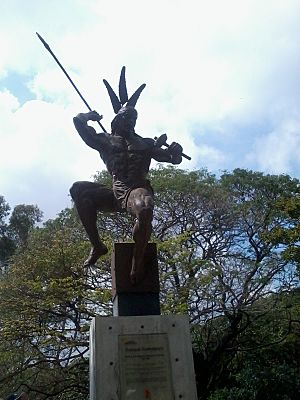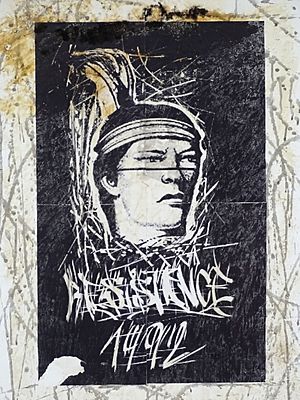Guaicaipuro facts for kids
Quick facts for kids
Cacique Guaicaipuro
(Guacaipuro) |
|
|---|---|

A statue of Guaicaipuro
|
|
| Born | c. 1530 Northern Venezuela Province (present day Los Teques, Venezuela)
|
| Died | 1568 (aged 37-38) Paracotos, Venezuela Province, Spanish Empire
|
Cacique Guaicaipuro was a very important indigenous (native) leader from Venezuela. He was a chief of the Teques and Caracas tribes. Even though we know him as Guaicaipuro today, old papers show his name was written as Guacaipuro.
Contents
Guaicaipuro's Early Life and Leadership
Guaicaipuro was a powerful leader in the 1500s. He brought together many different native tribes. He led them against the Spanish who were trying to take over Venezuelan land. This happened mostly in the central part of the country, near the Caracas valley.
Guaicaipuro's Family and Allies
Guaicaipuro was a famous Venezuelan cacique, which means a native chief. He led other important chiefs like Naiguatá, Guaicamacuto, Chacao, Aramaipuro, and Paramaconi. His own son, Baruta, was also a chief.
The area where the Teques lived had many native groups. Each group had its own chief. Guaicaipuro's tribe was the largest. They lived in what is now San Antonio de los Altos. We also know the names of two of his sisters: Tiora and Caycape.
Fighting the Spanish for Gold
The Spaniards found gold in the land of the Teques. When they started digging for it, Guaicaipuro attacked them. He forced the Spanish to leave the area.
Spanish Response and Guaicaipuro's Victory
After this attack, the governor of Venezuela Province sent Juan Rodríguez Suárez to calm things down. Rodríguez Suárez seemed to defeat Guaicaipuro in a few fights. He thought his job was done.
So, the Spanish commander and his soldiers left. They left behind miners and three of Rodríguez Suárez's sons. Once the Spanish soldiers were gone, Guaicaipuro attacked the mines again. He killed all the workers and Rodríguez Suárez's sons.
Right after this, Rodríguez Suárez was on his way to the city of Valencia. He had only six soldiers with him. He planned to meet Lope de Aguirre, another Spanish explorer. But Guaicaipuro's forces ambushed him, and Rodríguez Suárez was killed.
Uniting Tribes Against the Spanish
After these successes, Guaicaipuro became the main leader for all the native tribes. They rose up against the Spanish near the Caracas valley. He managed to unite all the tribes under his command.
In 1562, they defeated a Spanish group led by Luis Narváez. Because of these strong attacks, the Spanish stayed away from the area for several years.
The Founding of Caracas and Guaicaipuro's Death
In 1567, the city of Santiago de Leon de Caracas was started in the Caracas valley. The Spanish were worried about Guaicaipuro and his men being so close. They remembered his past attacks.
They decided not to wait for him to attack them. So, Diego de Losada, who founded Caracas, ordered the city's mayor, Francisco Infante, to capture Guaicaipuro.
In 1568, Infante and his men were led by native guides. They found the hut where Guaicaipuro lived. They set it on fire to make the native chief come out. Guaicaipuro was then killed by the Spanish soldiers.
Guaicaipuro's Legacy in Venezuela
Guaicaipuro is a very important figure in Venezuelan history. A county in Miranda, Venezuela, was named in his honor. This county later became the Guaicaipuro Municipality.
Honoring Indigenous Heroes
Former president Hugo Chávez started a new way of looking at history. He wanted to highlight the role of Venezuela's native chiefs and indigenous people. Before, history often focused more on the Spanish explorers.
Because of this, Guaicaipuro's remains were symbolically moved to the national pantheon on December 8, 2001. His actual remains have never been found. This was a special ceremony to honor him.
President Chávez often spoke about Guaicaipuro and other native chiefs in his speeches. He wanted to inspire Venezuelans to stand strong against what he called foreign interference. He did this every year on October 12. This day was renamed Día de la Resistencia Indígena (Day of Indigenous Resistance). It used to be called Dia de la Raza (Day of the Race).
Mission Guaicaipuro
The Venezuelan government also named one of its programs Mission Guaicaipuro. This program is part of the Bolivarian Missions. Its goal is to help Venezuela's 33 remaining indigenous tribes. It works to give them back their traditional land rights and protect their human rights.
See also
 In Spanish: Guaicaipuro para niños
In Spanish: Guaicaipuro para niños


